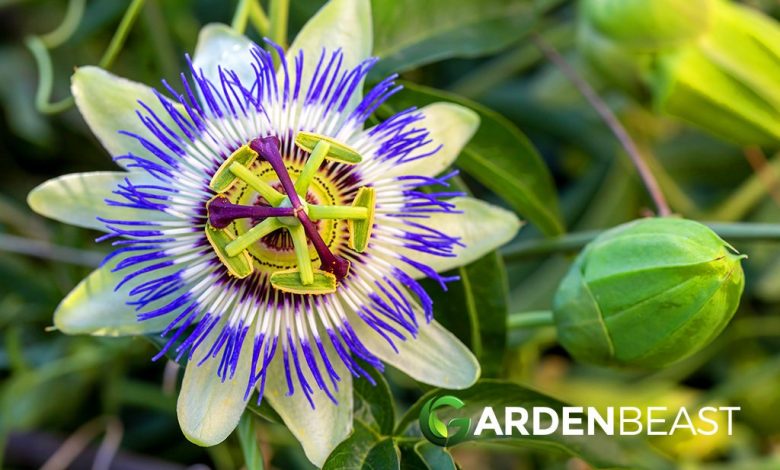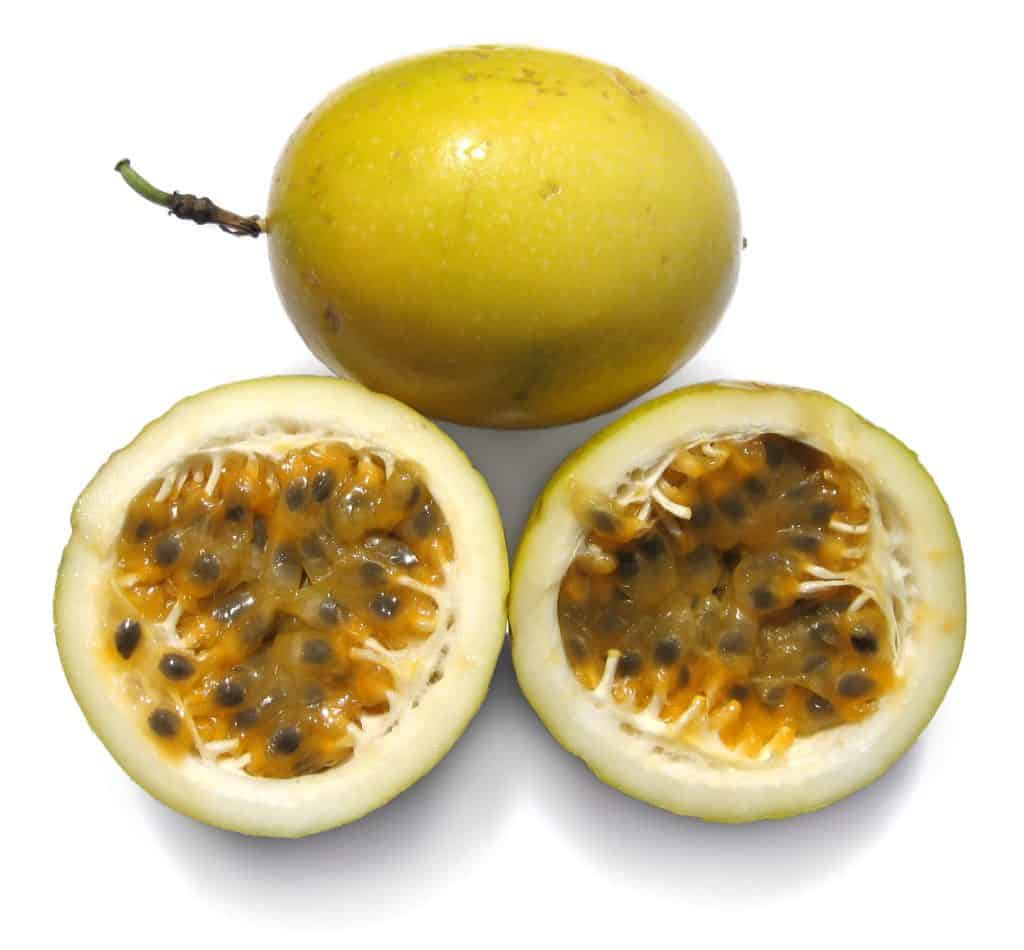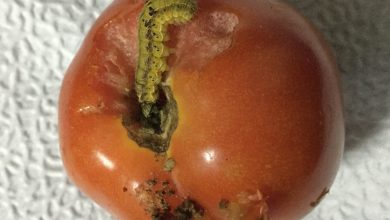How to Plant Passion Flower in Your Garden: [Complete Guide]

Passionflower, passion fruit plant or Passion Flower (Passiflora caerulea),It is a climbing tropical species of American origin, but whose fame has spread impressively in the world due to its spectacular fruit and the exotic flower that it has.
Did you know…In times of the so-called Conquest of the American continent, the Spaniards who saw it for the first time considered it a sign of good omen and assigned it a mystical relationship with the passion, life and death of Jesus Christ, represented by the different parts that make up its strange flower. and its life cycle, which seems to culminate in the winter but is resurrected in the spring.
The flower can also be eaten hermaphroditic and solitary. Havegreat sedative medicinal powersand provides large carbohydrates with a high caloric level.
Important points when planting the passion flower
- When to sow? It sprouts in May and grows until the first frost of the year.

- Where to sow? It is a climber that can be attached to walls, gazebos, terraces and there are species that can be planted in pots.
- How big can you get? Up to 9 meters high.
- Temperature: They do well at temperatures ranging from 18 to 27 °C and 10 °C in winter. They need a lot of sunlight.
- How do we prepare the land? The best soils are non-clay soils with a neutral pH.
- How do we water? From spring to summer, watering should be constant and spaced out in winter so as not to rot its roots due to excessive humidity.
- Plagues and diseases? It is attacked by the cottony mealybug, caterpillars on the leaves, bed bugs, red spider mite, aphids and Fusarium fungus, among other pests.
When to plant the passion flower?
 It has the peculiarity thatsprouts in mayand it grows until the first frost of the year occurs, when its branches dry up, it goes into hibernation and is reborn again in spring.
It has the peculiarity thatsprouts in mayand it grows until the first frost of the year occurs, when its branches dry up, it goes into hibernation and is reborn again in spring.
The Passiflora quadrangularis variety is one of the best known in Spain and the world.
It produces passion fruit, an edible fruit with an acid flavor that can be up to 30 cm long.
The Passiflora carulea is also widely seen in Europe. With 5-lobed leaves, it is fast growing andproduces many seeds that can be sown.
They flower from summer to early autumn and most Passiflora species are adapted to Mediterranean climates, living welltemperatures that oscillate between 18 to 27 °C and 10 °C in winter.
Where to plant the passion flower?
It is a climbing type plant, which is linked with help and is watered like a carpet, thus providing a lot of shade. So it can be used in the decoration of walls and terraces or gazebos, because it becomes a vine thatIt can reach up to 9 meters in height.
It is easy to grow in a garden as long as they have facilities for its maintenance and preservation.
There are even species that can be planted in pots where they grow quite well because their roots are superficial, but it is advisable to take them outside to enjoy the sun, although in winter they must be protected from the icy winds, which do not give them any comfort. they bring
Did you know…There are numerous varieties and hybrids, more than 400, of great ornamental and medicinal value.
How do we prepare the land for the cultivation of passionflower?
The best soils for Passion Flowerare those non-clay or sandy clay,with a neutral to slightly acidic pH and rich in organic nutrients.
 A good substrate ensures the best flower growth. A good mix is as follows: 1 portion of fertile substrate, 1 portion of peat and another of sand.
A good substrate ensures the best flower growth. A good mix is as follows: 1 portion of fertile substrate, 1 portion of peat and another of sand.
If the plant is grown in the garden, before its installation it is necessary to carry out a deep excavation to mix an approximate 30 percent of sand to the soil that we chose. This improves drainage.
And in the spring and even summer, a quality liquid fertilizer should be added.
How do we water the passion fruit or passion flower?
The Passion Flower from the spring time and during the summerIt has to be constantly supplied with water.so that the substrate always remains moist, not soaked or waterlogged.
In the winter period, watering is more spaced, very moderate but also keeping the substrate or soil moist.
How do we sow the passion flower step by step?
- Planting and multiplication can be done by seeds and woody cuttings with at least three nodes.
- In May, we can start by scraping one side of the seeds with very soft sandpaper before submerging them in water for a whole day.
- Prepare pots with sand at the bottom to ensure good drainage and quick drying of the soil. Use loose soil.
- Bury one seed per pot at an approximate depth of 2.5 cm and place it in a sunny place. Put a few drops of fertilizer the day after the act of transplanting and keep them constantly attended to with watering and lots of love.
- At the beginning of June, the first seedlings appear, approximately 3 cm high.
- Dig holes about 15 cm deep in an elevated place in the ground with good drainage.
- Locate the seedlings in rows approximately 3 meters apart and 1.5 meters between plants. Between each row, poles about 2 meters high are erected and wires are stretched between them, so that the plants can be held.
- It is essential that the plant has a support, guide or stake that supports it, until it can reach the pre-installed wires.
- By the end of June, the Passion Flower should already have reached growth averaging an inch a day. As they assume a rapid metabolic process, it is necessary to give them a lot of water at night, but without exaggerating so that the roots do not rot with unnecessary saturation of the potting soil.
- When winter arrives, you have to stop watering it because the death of the stem begins. The root will persist in surviving until spring and putting fertilizer in each pot every 6 weeks.
- The cultivation area cannot harbor weeds or mountains. It must always be clean. Training pruning, fertilization and irrigation are activities.
What pests and diseases does it have?
It is very sensitive to the cottony mealybug, caterpillars on the leaves and bugs, as well as spider mites or mites, pests that must be eliminated by biological or chemical control.
It is also common for the roots to rot due to the fungus of the genus Fusarium, which appears in very humid or floodable areas.
One very bothersome pest is a miniature white or yellow to green leaf-infesting insect called aphids or aphids. A pesticide will kill them.
If the leaves turn yellow and the plant does not flower, it may be missing a lot of natural light. And if the leaves fall quickly, then the watering is wrong and you should try to correct the situation by keeping the substrate always moist.



![Photo of Philodendron Xanadu: [Cultivation, Irrigation, Associations, Pests and Diseases]](https://www.complete-gardening.com/wp-content/uploads/2022/08/philodendron-xanadu-cultivation-irrigation-associations-pests-and-diseases-390x220.jpg)
![Photo of Varieties of Granada: [Characteristics and Classification]](https://www.complete-gardening.com/wp-content/uploads/2022/08/varieties-of-granada-characteristics-and-classification-390x220.jpg)
